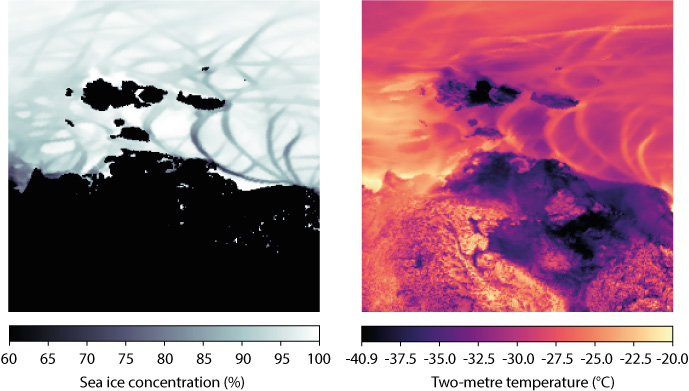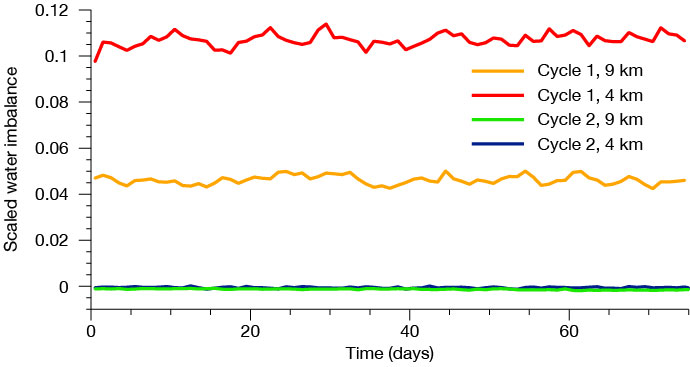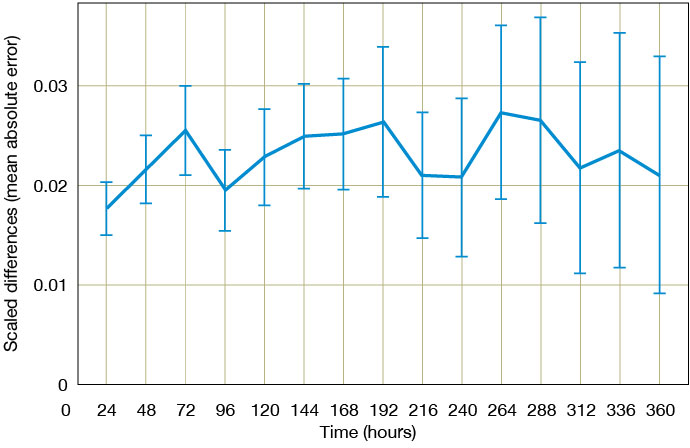

Increasing the horizontal resolution of forecasting models makes it possible to resolve more processes at smaller spatial scales, such as near steep orography in the mountains, and ultimately improve forecast skill. ECMWF is testing what needs to be done for its Integrated Forecasting System (IFS) to increase its performance at higher resolutions than those used for today’s operational forecasts.
As part of the nextGEMS project, ECMWF experts are looking, for example, into modelling sea ice cracks in the Arctic and fixing water and energy budget imbalances.
What is nextGEMS?
nextGEMS (Next Generation Earth Modelling Systems) is an EU-funded Horizon 2020 project that has been running since September 2021. It involves 26 institutes and is coordinated by the Max Planck Institute for Meteorology (Germany). It aims to develop two storm-and-eddy-resolving Earth system models and then apply them to study the Earth system and test hypotheses underpinning our understanding of climate change. The two models are:
- ECMWF’s IFS, coupled with two ocean models: NEMO, developed by the NEMO consortium, and FESOM, developed by the Alfred Wegener Institute (Germany)
- ICON, which is jointly developed by the Max Planck Institute for Meteorology and the German national meteorological service (DWD).
The km-scale grid of nextGEMS models makes it possible to partially explicitly resolve essential physical processes and to deliver information on scales where impacts of climate change and extreme events are felt. But along the way, insights from the km-scale simulations are already being used to improve the IFS at current operational resolutions.
The IFS is currently run operationally at 9 km for high-resolution forecasts and at 18 km for ensemble forecasts. Next year, the ensemble resolution is due to go up to 9 km as well. But nextGEMS is looking at resolutions far beyond that.
One aspect studied in the project is the benefits of a high-resolution ocean and sea ice model in the coupled system. This makes it possible to represent sea ice cracks in the ocean in the Arctic and the atmospheric response to them.
Another aspect studied in nextGEMS is how atmospheric processes are represented at km-scale resolutions (around 2 to 5 km). An interesting first finding of the project was that the non-conservation of water and energy in the IFS is exacerbated at these resolutions.
This is particularly problematic in long multi-year simulations like those planned in nextGEMS, as it can lead to model drifts. A solution to this issue was developed and will be implemented in the next IFS operational upgrade next year.
“The work done in nextGEMS will be useful as we increase the resolution of the IFS, both for future operational ensemble forecasts at convection-permitting resolutions, foreseen in our 2021–2030 Strategy, and for our contribution to the EU’s new Destination Earth (DestinE) initiative,” says ECMWF’s Irina Sandu, the science lead for DestinE at ECMWF and nextGEMS co-coordinator.

As explained in a nextGEMS video clip, the development of digital twins as part of DestinE will be based on prototypes of storm-and-eddy-resolving models like those developed in nextGEMS.
DestinE will develop several digital twins, or highly accurate replicas, of the Earth, relying on a fusion of high-resolution Earth system models, like those developed in nextGEMS, and observations. It will thus contribute to revolutionising the European capability to monitor and predict our changing planet and complement existing national and European services, such as the EU's Copernicus services.
Model development cycles
The nextGEMS model development is structured into simulation cycles. In these cycles, the models are improved and the simulation length is gradually increased from a few months up to 30 years.
In the latest cycle, completed in the first part of 2022, different experiments have been performed coupling a high-resolution IFS (4.5 and 3 km) to a high-resolution ocean model, FESOM, that resolves eddies in large parts of the globe.
These experiments were one year and, respectively, eight months long. More details on the experiments can be found in a nextGEMS article.
The latest nextGEMS simulations have also made use of IFS model developments for land and atmospheric processes, which are to become operational next year, as part of IFS Cycle 48r1.
“nextGEMS tests IFS model developments at higher resolutions than those used for our operational ECMWF forecasts,” says ECMWF scientist Xabier Pedruzo Bagazgoitia. “This allows us to already prepare for resolutions which will be used in a few years’ time for our operational forecasts.”
Sea ice cracks
The operational IFS currently uses the NEMO ocean model at 1/4 degree resolution (about 25 km at the equator). For the nextGEMS experiments, the IFS has been coupled to the multi-resolution FESOM sea ice/ocean model. This was run at a resolution of about 4–5 km in mid- and high latitudes and about 13 km in those parts of the tropics where eddies are large or non-existent.
A sequence of sea ice leads in the Arctic as explicitly simulated by the FESOM ocean-sea ice model at a resolution of about 4–5 km.
“We have seen that in this high-resolution model of the ocean and sea ice, sea ice cracks develop in the Arctic. The atmosphere responds to that through changes in cloud cover and two-metre temperature,” says ECMWF’s scientist Thomas Rackow. “These imprints of sea ice on the atmosphere are something entirely new for a global Earth system model.”

Sea-ice concentration and two-metre temperature around the New Siberian Islands in the Arctic Ocean in the IFS at a resolution of 3 km, coupled to a FESOM sea ice/ocean model at a resolution of 4 to 5 km in the Arctic. The charts show the results of simulations for 13 February 2020 at 08 UTC.
Water and energy budget
Work to significantly improve the conservation of water and energy in the IFS was also triggered by the nextGEMS project. The simulations performed in the first nextGEMS development cycle (labelled cycle 1) showed that water and energy imbalances become considerably worse at km-scale resolutions, particularly if the deep convection parametrization is switched off.
Further investigation at ECMWF established that most of the energy imbalance in the IFS was due to water not being conserved. The water non-conservation of the IFS had been known for a long time. However, it was thought that while this matters for multi-annual to climate timescales, it would not affect much the quality of weather forecasts on medium-range timescales.
To address the problem of water non-conservation in the IFS, global tracer mass fixers were activated for all moist species, including water vapour.

The chart shows daily mean water non-conservation in the IFS, computed as the daily change in globally integrated total water in the atmosphere, taking account of surface evaporation and precipitation, as a fraction of the daily precipitation. Results are shown as a function of lead time for nextGEMS Cycle 1 and Cycle 2 simulations, with deep convection parametrization at 9 km and without deep convection parametrization at 4.5 km, started on 20 January 2020.
The chart shows that, when global mass fixers are used in the latest nextGEMS simulations (labelled Cycle 2), the global water non-conservation is essentially eliminated. Meanwhile, the global energy budget imbalance has reduced from a few Wm–2 to less than 1 Wm–2.
“Experiments have shown that global water conservation improves the quality of ECMWF’s medium-range weather forecasts even at a resolution of 9 km,” says ECMWF’s scientist Tobias Becker.

The chart shows scaled differences between forecasts with and without global water conservation with respect to the mean absolute error in precipitation against rain gauge measurements over the northern hemisphere, as a function of lead time. Positive values mean the forecasts with global water conservation are better. Forecasts are run at 9 km resolution for summer 2020 and winter 2021. The intervals show a 95% confidence level.
The chart shows improvements in forecast skill in precipitation forecasts, but significant improvements are also found for some other parameters, such as temperature at 200 and 500 hPa. The tracer mass fixers are expected to be activated in IFS Cycle 48r1.
More details on the changes in the water and energy budget can be found in the summer edition of the ECMWF Newsletter.
nextGEMS is funded through the European Union’s Horizon 2020 research and innovation program under grant agreement number 101003470.
